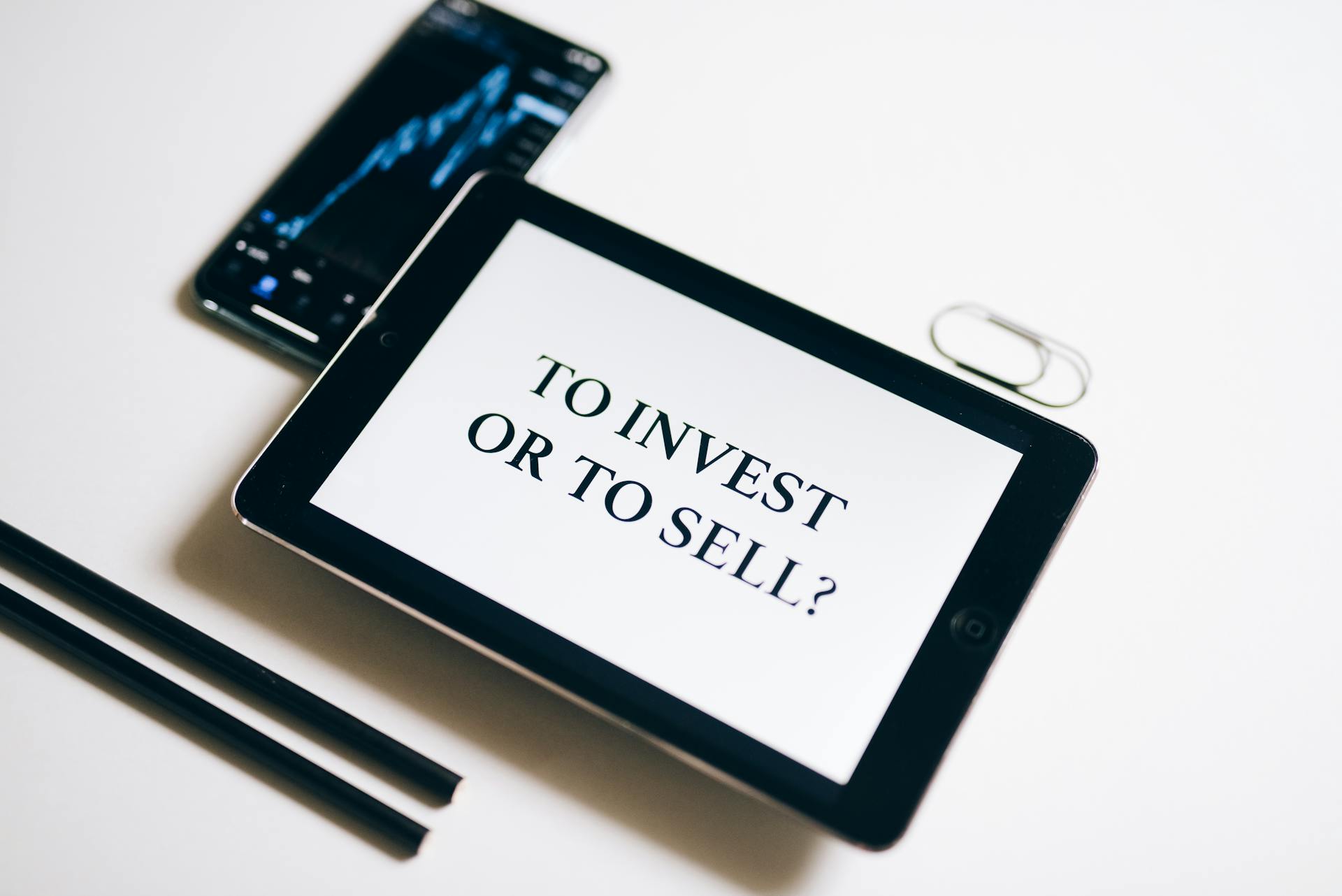
Investing is a journey, not a destination, and it's essential to understand the risk return tradeoff to make informed decisions. A key concept to grasp is that higher potential returns often come with higher levels of risk.
There are various ways to measure risk, including standard deviation and volatility. Standard deviation measures the amount of variation or dispersion in a set of data, while volatility measures the frequency and magnitude of price movements.
Risk tolerance is a crucial factor in determining the right investment strategy for you. If you're risk-averse, you may want to consider more conservative investments, such as bonds or money market funds, which offer relatively lower returns but also lower risk.
If this caught your attention, see: Risk Measures
What Is the Risk-Return Tradeoff?
The risk-return tradeoff is a fundamental concept in investment management. It's the idea that higher-risk investments can potentially yield higher returns.
Every investment instrument comes with a certain level of risk, where investors can lose their capital amount due to various negative factors. The level of risk depends on the investment duration, the instrument's volatility, and the investor's risk tolerance.
Investing with low levels of risk can provide stable but not high returns. Ideally, investing for the long term allows investors to potentially lower the risk and achieve higher returns.
Investment duration plays a crucial role in allowing investors to utilise the risk-return tradeoff. If one wants to make high profits in the short term, the risk factor is higher with the possibility of higher returns.
See what others are reading: The Dhandho Investor the Low-risk Value Method to High Returns
Calculating Risk-Return Tradeoff
Calculating risk-return tradeoff involves evaluating a mutual fund's performance in relation to its benchmark index. This is done using various ratios, including the alpha ratio, beta ratio, and Sharpe ratio.
Alpha ratio measures the excess returns on a mutual fund investment by comparing it to its benchmark index. A positive alpha indicates outperformance, while a negative alpha suggests underperformance.
The beta ratio measures a mutual fund's sensitivity to market movements, determining its volatility in relation to the overall market. A beta of 1 means the fund is highly correlated with the benchmark, while a beta of 0 indicates no correlation.
Recommended read: Gold Silver Ratio When to Buy
The Sharpe ratio assesses a fund's risk-adjusted return by comparing its excess return to its standard deviation. A higher Sharpe ratio indicates better risk-adjusted returns.
Investors use these ratios to evaluate the risk-return tradeoff and make informed decisions about their investments. By understanding the relationship between risk and return, investors can manage their risks better and potentially earn higher returns.
Here are the key metrics used to evaluate the risk-return tradeoff in mutual funds:
- Alpha ratio: measures excess returns on a mutual fund investment
- Beta ratio: measures a mutual fund's sensitivity to market movements
- Sharpe ratio: assesses a fund's risk-adjusted return
These ratios help investors identify investments that offer the best potential return for their level of risk tolerance, allowing them to optimise their portfolio for investment objectives.
Risk-Return Tradeoff Strategies
The risk-return tradeoff is a crucial concept in investing that helps you balance risk and potential returns. By considering your personal risk tolerance and financial objectives, you can make informed decisions about your investments.
To construct a diversified portfolio, fund managers use the risk-return tradeoff to select assets that align with investors' risk-return preferences. This involves considering factors such as financial objectives, risk tolerance, and investment duration.
Investors can use the risk-return tradeoff to evaluate the performance of mutual funds, develop investment strategies, and maximize their returns while managing their risks. By understanding the relationship between risk and return, investors can make informed decisions about their investments.
Here are some key strategies for balancing risk and return in your portfolio:
- Asset allocation: Divide your investments across various asset classes based on your goals and risk tolerance.
- Diversification: Spread your investments across various assets, sectors, geographic regions, and company sizes to reduce unsystematic risk.
- Regular portfolio rebalancing: Periodically adjust your portfolio to maintain your desired asset allocation and risk level.
These strategies can help you manage your risk, optimize your returns, and achieve your investment goals.
Uses of Strategies
The risk-return tradeoff is a fundamental concept in investing that helps you make informed decisions about your investments. It's a simple yet powerful tool that can help you balance your risk and return expectations.
By using the risk-return tradeoff, you can create a diversified portfolio that meets your investment goals. This means selecting a mix of assets that balance your risk and return expectations, such as stocks, bonds, and cash.
One way to use the risk-return tradeoff is to evaluate the performance of mutual funds. By analyzing the risk-return tradeoff, you can identify which funds are most likely to meet your investment goals.
You can also use the risk-return tradeoff to develop investment strategies that maximize your returns while managing your risks. This involves identifying your risk tolerance and investment goals, and then selecting a portfolio that aligns with those goals.
Here are some key strategies for using the risk-return tradeoff:
• Measuring singular risk in context: This involves evaluating the risk and return of individual investments, such as stocks or bonds.Risk-return trade-off at the portfolio level: This involves evaluating the overall risk and return of your portfolio, taking into account the risk and return of each individual investment.
By using these strategies, you can create a portfolio that balances your risk and return expectations and helps you achieve your investment goals.
To calculate the risk-return tradeoff, you can use various metrics, such as the alpha ratio, beta ratio, and Sharpe ratio. These metrics help you evaluate the excess returns on your investments and the level of risk associated with those returns.
Here are some key metrics used to calculate the risk-return tradeoff:
• Alpha ratio: This measures the excess returns on your investments compared to a benchmark index.Beta ratio: This measures the sensitivity of your investments to movements in the market or a particular benchmark index.Sharpe ratio: This measures the excess return per unit of risk, helping you evaluate the risk-adjusted return on your investments.
By using these metrics, you can get a better understanding of the risk-return tradeoff and make more informed investment decisions.
Intriguing read: Asset Return Ratio
In addition to using metrics, you can also use dollar-cost averaging and regular portfolio rebalancing to help manage your risk and return expectations. These strategies can help you mitigate the impact of market volatility and ensure that your portfolio remains aligned with your investment goals.
By combining these strategies with the risk-return tradeoff, you can create a comprehensive investment plan that helps you achieve your financial goals.
Options and Futures
Options and futures can provide leverage on underlying assets, increasing returns but also risks.
This leverage can be particularly appealing to investors who are looking to maximize their gains, but it's essential to remember that it also amplifies potential losses.
In some cases, derivatives like options and futures can be used to hedge, which decreases the overall risk of a portfolio due to negative correlation with other investments.
By using derivatives in this way, investors can potentially reduce their exposure to market volatility and protect their portfolio from significant losses.
Curious to learn more? Check out: Trading Futures vs Stocks
Risk-Return Tradeoff
The risk-return tradeoff is a fundamental concept in investing that can be tricky to navigate. A beta of 1.2 means a stock is 20% more volatile than the market, making it a riskier investment.
To make informed decisions, investors use various metrics, including the Sharpe ratio, which evaluates if the return justifies the risk taken. A higher Sharpe ratio indicates better risk-adjusted performance, with a ratio of 1.5 indicating a high risk-adjusted return compared to peers.
The risk-reward ratio is calculated by dividing the expected return of a trade by the amount of invested capital. Traders often aim for a risk-reward ratio of at least 2:1 or higher to ensure the potential profit outweighs the loss.
Investments with higher risks do not necessarily yield better returns. In fact, a higher level of volatility can result in huge investment losses, making it essential to consider personal investment factors, such as risk tolerance and investment duration.
Here's a brief summary of the key metrics:
- Beta: measures how an investment moves relative to the market (e.g., a beta of 1.2 means the stock is 20% more volatile than the market)
- Sharpe ratio: evaluates if the return justifies the risk taken (e.g., a ratio of 1.5 indicates a high risk-adjusted return)
- Risk-reward ratio: calculated by dividing the expected return of a trade by the amount of invested capital (e.g., aiming for a ratio of at least 2:1 or higher)
Real-World Applications
In finance, the risk-return tradeoff is a fundamental concept that guides investment decisions. It's a delicate balance between the potential rewards of an investment and the potential losses.
Investors often face a tradeoff between investing in a high-risk, high-reward stock versus a low-risk, low-reward bond. For example, a stock with a high potential return may also come with a higher risk of losing some or all of the investment.
In the corporate world, companies like Amazon and Google have made bold investments in emerging technologies, taking on significant risk in pursuit of high returns. These investments have paid off, making them two of the world's most valuable companies today.
If this caught your attention, see: High Yield Dividend Stocks 2023
Loans to Blue-Chip Corporations
Blue-chip corporations with high credit ratings offer a relatively low-risk investment option. Short-dated bills of exchange from these corporations are a good place to start, as they have a lower risk profile compared to other investments.
These corporations are considered blue-chip because they have a strong financial history and are less likely to default on their loans. The risk-free rate of return is still a good benchmark for comparison, but the returns on these investments are slightly higher due to the time-preference and inflation premium components.
As the maturity of the debt increases, the risk-return spectrum shifts, and the expected return also increases. This means that longer-term debt from well-rated corporations will have a higher yield and thus a higher expected return compared to short-term debt.
The credit rating of the corporation plays a significant role in determining the risk-return profile of the investment. A lower credit rating means a higher yield and a higher expected return, but also a higher risk of default.
On a similar theme: Credit Risk Modeling
Rental Property
Rental property can be a good investment option, but it's essential to understand the risks involved. Commercial properties that are rented out have a comparable risk or return to a low-investment grade.
Industrial property tends to have higher risk and returns than other types of rental properties. This is likely due to factors such as market demand and property maintenance costs.
If you're considering investing in a rental property, it's worth noting that residential properties have higher returns than commercial properties. However, they also come with their own set of challenges, such as dealing with tenants and property management.
Cryptocurrencies
Cryptocurrencies are considered very high-risk investments, representing a stake in a new monetary system of questionable potential.
Investing in cryptocurrencies like Bitcoin and Ethereum can be similar to buying small cap stocks, with similar volatility in recent years.
The crypto market crash of 2022 demonstrated the potential for high returns, but also the risk of substantial losses.
Cryptocurrency investments are considered high-risk and may not be suitable for all investors, making them a potentially unsound choice for those seeking stable returns.
These digital assets offer potentially high returns, but come with significant volatility and regulatory risks that can impact their value.
Expand your knowledge: Private Equity Co Investments
Emerging Trends
Emerging Trends can significantly impact the risk-return landscape of investments.
New investment trends often prioritize sustainability and social responsibility, which can lead to a shift in risk tolerance among investors.
Investors are increasingly looking for opportunities that align with their values, such as investing in renewable energy or socially responsible companies.
This trend can result in a higher risk of investment losses, but also potentially higher returns in the long term.
Investors should carefully consider their risk tolerance and investment goals before investing in emerging trends.
Emerging trends can also create new opportunities for investors, such as investing in cutting-edge technologies or innovative companies.
Investors should stay informed and adapt to changing market conditions to maximize their returns.
Related reading: How Do Angel Investors Make Money
Factors Influencing Risk-Return Tradeoff
Your personal risk tolerance is influenced by several factors, including your financial goals and obligations. This means that saving for retirement or a child's education can require a more conservative approach.
Your current financial situation also plays a role in determining your risk tolerance. A higher income or substantial savings might allow for more risk-taking. This is because you have a safety net to fall back on.
Ultimately, your required rate of return, which is the return your portfolio must earn to reach your financial goals, will influence your risk-return tradeoff. This can make choosing between investments with different risk profiles a subjective decision.
Psychological Factors
Your personal comfort level with uncertainty plays a significant role in your risk tolerance. Some people are naturally more comfortable with risk than others, which can influence their investment decisions.
You might be someone who is always out base jumping or wing-suit flying, always seeking the next thrill, and willing to take on higher risk for potentially higher returns. On the other hand, you might be someone who prefers a more stable and predictable life, and is more cautious when it comes to investing.
Your risk tolerance is subjective and can be influenced by your individual personality and experiences. Understanding your own comfort level with uncertainty is crucial in creating an investment strategy that you can stick with through market ups and downs.
As you explore your investment options, consider whether you're someone who is naturally more risk-averse or risk-seeking. This self-awareness can help you make more informed decisions about your investments and achieve your financial goals.
Global Events
Global events can significantly impact the risk-return tradeoff. Ongoing geopolitical tensions in 2023 have led to increased volatility in energy markets, affecting both risk and potential returns in this sector.
Investors may want to stay informed about global events and consider how they might affect their portfolio. This might involve adjusting asset allocations or increasing diversification to potentially mitigate risks.
Global events can be unpredictable, but understanding their potential impact on your investments is crucial. Staying informed about global events can help you make more informed investment decisions.
In 2023, geopolitical tensions have already led to increased volatility in energy markets. This is a clear example of how global events can affect the risk-return tradeoff.
Broaden your view: Global Risk Report Wef
ESG Investing
ESG Investing is an approach that considers ethical and sustainability factors alongside financial returns. This method may offer potential long-term stability.
While ESG Investing may provide a more stable investment, it may also limit some high-return opportunities in certain sectors.
ESG Investing considers Environmental, Social, and Governance factors.
Explore further: Esg Risk Score Meaning
Sources
- https://www.bajajfinserv.in/investments/risk-return-trade-off-explained
- https://en.wikipedia.org/wiki/Risk%E2%80%93return_spectrum
- https://modelinvesting.com/articles/the-risk-return-trade-off/
- https://www.5paisa.com/stock-market-guide/mutual-funds/risk-return-trade-off
- https://m1.com/knowledge-bank/risk-return-tradeoff-balancing-investment-goals/
Featured Images: pexels.com


